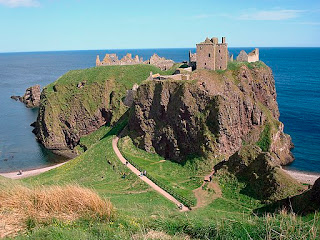Kim Traynor, CC BY-SA 3.0 <https://creativecommons.org/licenses/by-sa/3.0>, via Wikimedia Commons
The huge crowd waiting on Castle Hill cheered loudly as they watched the Royal Standard rise above/Edinburgh Castle. They hugged each other, dancing for joy. The Honours of Scotland, the oldest Crown Jewels in the British Isles, had been found.
After a long struggle, Sir Walter Scott had received a Royal Warrant allowing him to accompany the Scottish Officers of State to search the sealed Crown Room in the castle for the Honours. Few thought that they would actually be stored away there safely. However, it was Scotland's and the great writer's lucky day. The jewels were wrapped carefully in linen in an iron-bound oak chest. It was February 4, 1818, and they had been locked away since the Treaty of Union with England in 1707.
The crest of the royal arms of Scotland shows the red lion of the King of Scotland wearing the crown, and holding the sword and sceptre. These three components make up the regalia of the Honours. When Scottish monarchs were first crowned, they wore gold circlets on their heads. These became fancier, and more detailed over the years. The sword was an 'instrument of sovereignty', and a symbol of power, while the sceptre indicated that the monarch would rule with 'dignity and propriety'.1.
The Crown
The Scottish Parliament., CC BY 2.0 <https://creativecommons.org/licenses/by/2.0>, via Wikimedia Commons
The present crown dates from around 1540 when James V instructed Mosman, an Edinburgh goldsmith, to refashion the original crown. It consisted of a circlet of Scottish gold, 22 new gemstones, and precious stones from previous crowns, along with freshwater pearls from Scottish rivers. A velvet and ermine bonnet was added later.
A picture of the previous crown was included in the Book of Hours commissioned for the wedding of James IV and Margaret Tudor (Henry VIII's sister) in 1503.
The Sceptre
Scotland was regarded as 'a special daughter of the Holy See', so it was a recipient of papal gifts. Pope Alexander V gave the sceptre to James IV in 1494.James V also had this remodelled and lengthened in 1536 by the Edinburgh goldsmith Adam Leys. It is a handle attached to a hexagonal rod, engraved with thisles, fleurs-de-lis, and many other images, topped with a finial of rock crystal probably from the Cairngorm Mountains.
Originally made in Italy of silver gilt, it was remodelled and lengthened for James V in 1535 by the Edinburgh goldsmith Adam Leys. 86 cm long, it consists of a handle attached to the bottom of a hexagonal rod, engraved with floral images, fleurs-de-lis and grotesques. Stylised dolphins (a symbol of the early Church) and figures, including one of St Andrew, are at the top of the sceptre.
The Sword of State
The Sword of State was another papal gift to James IV, this time from Pope Julius II. This was beautifully crafted by the Italian Domenico da Sutri, and elegantly decorated with oak trees, which symbolise the risen Christ, and dolphins. The sword's base is etched on both faces with the figures of St Peter and St Paul, along with the Pope's name in inlaid gold lettering.
The sword also features a scabbard, covered in dark red velvet, and an enamelled panel with the arms of the Pope, and a symbol of the papacy. Images of oak leaves, acorns, dolphins and grotesques also adorn the scabbard. The belt is made of silver and gold thread.
The Honours were first used for the coronation in 1543 of Mary, Queen of Scots, just a baby, who reportedly cried all through it. They were also prominent at James VI's coronation in 1567, and Charles I's in 1633. Charles II's coronation in 1651 in Scotland in the middle of the Civil War so angered Oliver Cromwell that the Scots were terrified of his getting hold of the precious Honours, and ordering them sold, or melted down. They were ordered by the Scottish authorities to be hidden, and first taken to the gloomy fortress of Dunottar Castle. This was besieged for 8 months, so the brave local minister's wife and her friend, took them to Kinneff church (perhaps in a lobster pot!) under the floor for nine years.
The Honours of Scotland were put on public display in 1822 when George IV visited Scotland, and they have been used for many state occasions since. The Honours were presented to King Charles III in celebrations on July 5, 2023, but the old sword was deemed too fragile. A new sword, dubbed the 'Elizabeth Sword' was used for the occasion.
1. Burnett, C.J. Tabraham, C.J. (2001). The Honours of Scotland. The Story of the Scottish Crown Jewels. United Kingdom: Historic Scotland, p.22











